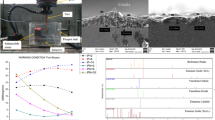Abstract
Wire electrical discharge machining (WEDM) process provides a cost effective solution to generate complicated shapes in various exotic materials, irrespective of their hardness. However, WEDM process removes the material by thermal erosion mechanism which in term affects the topography and mechanical characteristics of the material. In view of this, an effort is needed to eliminate the adverse effect of WEDM process on the final product surface. Therefore, the present work evaluates surface morphology, surface roughness, elemental composition, micro-hardness and residual stress of the machined surface produced by various WEDM strategies such as, rough cut and finish cut. Two post-processing techniques namely, grinding and etching-grinding are proposed to remove recast layer and also to improve the surface integrity of the machined surface. The proposed strategy found to be an efficient post-processing technique for complete removal of recast layer and generation of surface with an average surface roughness as low as 0.024 μm, high compressive residual stress as high as 500 MPa and basic elemental composition. The basic mechanism of these process are also explained in details.
Similar content being viewed by others
References
Jawahir IS, Brinksmeier E, M’Saoubi R, Aspinwall DK, Outeiro JC, Meyer D, Umbrello D, Jayal AD (2011) Surface integrity in material removal processes: recent advances. CIRP Ann Manuf Technol 60:603–626
Ulutan D, Ozel T (2011) Machining induced surface integrity in titanium and nickel alloys: a review. International Journal of Machine Tools & Manufacture 51:250–280
Pramanik A, Arsecularatne JA, Zhang LC (2008) Machining of particulate-reinforced metal matrix composites, Machining Fundamental and Recent Advances, Springer 127–166
Boswell B, Islam MN, Pramanik A (2013) Sustainable machining of aerospace material, In Proceedings of the World Congress on Engineering Vol. 3
Mandal A, Dixit AR (2014) State of art in wire electrical discharge machining process and performance. Int J Mach Mach Mater 16(1):1–21
Azam M, Jahanzaib M, Abbasi JA, Abbas M, Wasim A, Hussain S (2016) Parametric analysis of recast layer formation in wire-cut EDM of HSLA steel. Int J Adv Manuf Technol. doi:10.1007/s00170-016-8518-3
Liu JF, Li L, Guo YB (2014) Surface integrity evolution from main cut mode to finish trim cut mode in W-EDM of shape memory alloy. Appl Surf Sci 308:253–260
Lin HC, Lin KM, Chen YS, Chu CL (2005) The wire electro-discharge machining characteristics of Fe–30Mn–6Si and Fe–30Mn–6Si–5Cr shape memory alloys. J Mater Process Technol 161:435–439
Newton TR, Melkote SN, Watkins TR, Trejo RM, Reister L (2009) Investigation of the effect of process parameters on the formation and characteristics of recast layer in wire-EDM of Inconel 718. Mater Sci Eng A 513–514:208–215
Kuriakose S, Shunmugam MS (2004) Characteristics of wire-electro discharge machined Ti6Al4V surface. Mater Lett 58:2231–2237
Yan BH, Wang CC, Chow HM, Lin YC (2000) Feasibility study of rotary electrical discharge machining with ball burnishing for Al2O3/6061Al composite. International Journal of Machine Tools & Manufacture 40:1403–1421
Tamura T (2013) Development of on-the-machine surface modification technology in EDM. Procedia CIRP 6:117–122
Klink A, Guo YB, Klocke F (2011) Surface integrity evolution of powder metallurgical tool steel by main cut and finishing trim cuts in wire-EDM. Procedia Engineering 19:178–183
Huang CA, Hsu CC, Kuo HH (2003) The surface characteristics of P/M high-speed steel (ASP 23) multi-cut with wire electrical discharge machine (WEDM). J Mater Process Technol 140:298–302
Mandal A, Dixit AR, Das AK, Mandal N (2016) Modelling and optimization of machining Nimonic C-263 super alloy using multi-cut strategy in WEDM. Mater Manuf Process 31(7):860–868
Klocke F, Klink A, Veselovac D, Aspinwall DK, Soo SL, Schmidt M, Schilp J, Levy G, Kruth JP (2014) Turbomachinery component manufacture by application of electrochemical, electro-physical and photonic processes. CIRP Ann Manuf Technol 63(2):703–726
Klocke F, Welling D, Dieckmann J, Veselovac D, Perez R (2012) Developments in wire-EDM for the manufacturing of fir tree slots in turbine discs made of Inconel 718. Key Eng Mater 504–506:1177–1182
Aspinwall DK, Soo SL, Berrisford AE, Walder G (2008) Workpiece surface roughness and integrity after WEDM of Ti–6Al–4V and Inconel 718 using minimum damage generator technology. Annals of CIRP 57(1):187–190
Puri AB, Bhattacharyya B (2005) Modelling and analysis of white layer depth in a wire-cut EDM process through response surface methodology. Int J Adv Manuf Technol 25:301–307
Loveless T, Williams R, Rajurkar K (1994) A study on the effects of abrasive flow finishing on various machined surfaces. J Mater Process Technol 47(1–2):133–151
Amineh SK, Tehrani AF, Mohammadi A (2013) Improving the surface quality in wire electrical discharge machined specimens by removing the recast layer using magnetic abrasive finishing method. Int J Adv Manuf Technol 66:1793–1803
Fordham J, Pilkington R, Tang C (1997) The effect of different profiling techniques on the fatigue performance of metallic membranes of AISI 301 and Inconel 718. Int J Fatigue 19(6):487–502
Pramanik A, Basak A (2013) Ultra-precision machinability and properties of electroless-nickel. Adv Mater Res 651:344–349
Ezugwu EO, Bonney J, Yamane Y (2003) An overview of the machinability of aero-engine alloys. J Mater Process Technol 134(2):233–253
Wang CC, Chow HM, Yang LD, Lu CT (2009) Recast layer removal after electrical discharge machining via Taguchi analysis: a feasibility study. J Mater Process Technol 209:4134–4140
Hogg R, Tanis E (2001) Probability and statistical interference, sixth ed., Prince-Hall
Pramanik A (2016) Electrical discharge machining of MMCs reinforced with very small particles. Mater Manuf Process 31(4):397–404
Pramanik A, Basak AK, Islam MN, Littlefair G (2015) Electrical discharge machining of 6061 aluminium alloy. Trans Nonferrous Metals Soc China 25(9):2866–2874
Pramanik A, Neo KS, Rahman M, Li XP, Sawa M, Maeda Y (2009) Ultraprecision turning of electroless nickel: effects of crystal orientation and origin of diamond tools. Int J Adv Manuf Technol 43(7–8):681–689
Author information
Authors and Affiliations
Corresponding author
Rights and permissions
About this article
Cite this article
Mandal, A., Dixit, A.R., Chattopadhyaya, S. et al. Improvement of surface integrity of Nimonic C 263 super alloy produced by WEDM through various post-processing techniques. Int J Adv Manuf Technol 93, 433–443 (2017). https://doi.org/10.1007/s00170-017-9993-x
Received:
Accepted:
Published:
Issue Date:
DOI: https://doi.org/10.1007/s00170-017-9993-x




